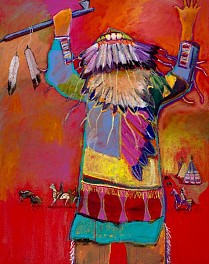BIOGRAPHY

Malcolm Furlow is one of the most important artists of the American Southwest. His expressionistic paintings depicting Native American figures and themes are striking with their bold color palettes. Each piece is infused with a sense of strength and spirituality. With an immense international following, Furlow is required study in many art schools throughout the world.
Furlow's father was half Choctaw. His grandfather was taken as a boy to a Christian school, had his braids cut off and was beaten for speaking his traditional language. As a young boy in Louisiana, Furlow saw Indians being hung in his own neighborhood. Under the cover of night, the family moved to Dallas, Texas where they felt it was safer. Instructed by his father to never mention his heritage, Furlow never met his Choctaw relatives. His artwork comes from his DNA, not his experiences, often channeling powerful images of a life he never knew.
Furlow’s roots fuel his paintings as a vehicle of social commentary, and through them he addresses the attempted genocide of the indigenous peoples of North America. Though he was not raised in a household that practiced Choctaw traditions, his work upholds the legacy of his ancestors and channels an understanding that runs deep in his peoples’ collective history.
With more than 50 sold out solo exhibitions and countless sold out group show, Furlow’s paintings command principal placement in exhibitions, philanthropists’ campaigns, and private collections around the world. He has won some of the most prestigious art awards, including the Luxembourg Art Prize (Silver) and the Gold Award at the Sorbonne, Paris (an honor shared with Pablo Picasso). Furlow’s work is included in the permanent collection of the White House. His work has received innumerable other awards and accolades and several documentaries have been made about Malcolm Furlow and his place in art history.
